Etsu Egami is a Japanese contemporary artist who was raised and studied in Europe, America, and China. In a cross-cultural context, she understands the charm and characteristics of language, inspiring her to decipher the true nature of language through the visual language of art. The differences, mishearing, and misunderstandings caused by various languages and words are transformed into the fuel for her art. And the Individual faces she met in various countries have already formed distinct color spectrums in her mind, beneath the form of horizontal, vertical, and twisted lines, like a swimming rainbow with a gentle force. The international color map created by Egami Etsu is constantly resolving the conflicts between people and different cultures. As the third generation of postwar contemporary artists in Japan, Etsu Egami is a rising star.
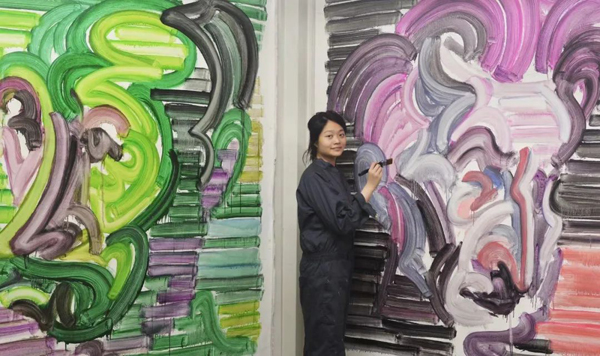
Hu Lingyuan: I think your paintings show a gradual change. For instance, your recent pieces are more colorful and more skillful in the brushwork technique and style when compared to your earlier works. Can you talk about this thinking process?
Etsu Egami : The idea of gradualness and change is intriguing. I believe it is similar to a process of the spiral staircase, in which starting a new journey and meeting new people broadens your perception, and then at some point, these perceptions rebound to yourself, helping you to know more about yourself. At the same time, you gain a new perspective and can see higher and farther. As a result, self-perception and works tend to change unconsciously again in this cyclical process.
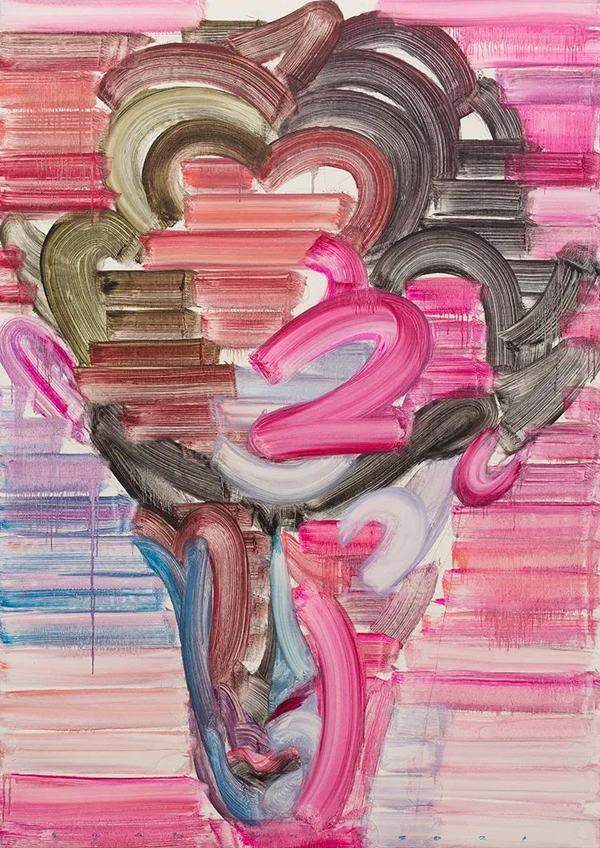
Rainbow-2021-T-13, 2021, oil on canvas, 200x140cm. Courtesy of the artist
Hu Lingyuan: These colored lines on your canvas look like a swimming multiplicity of colors, as if each viewer could make resonant with them and get their own piece of color. What does color mean to you?
Etsu Egami: Color, to me, symbolizes the spectrum of a person. In fact, the intuition, hearing, and illusion that pass by will be visualized as colors in my images. I have two solo shows that are pertained to this viewpoint, one is “Rainbow” at Karuizawa Art Museum in August 2021, and the other is “Rainbow” in Switzerland in April 2022. “Rainbow”, as the theme I have been exploring, is primarily concerned with the symbolic language of “communication.” We commonly express “misunderstanding” and “stubbornness,” which can be understood as misalignment and parallel communication, as well as an essential form of communication. They represent not only mutual respect in coexistence but also a significant opportunity for self-revelation. As we gaze into the sense of distance and uncertainty, the essence of communication may gradually emerge. I felt like I was seeing a rainbow in the gray area of communication at this point, and I could see the richness of meaning in all colors. Each color carries its own unique temperature and dignity. Those deeper and more essential things spring up more clearly in the moment of “misunderstanding.”
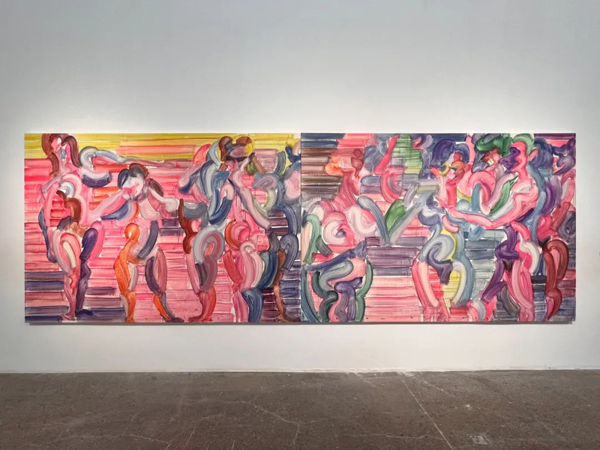
Rainbow, Courtesy of the artist
Hu Lingyuan: Your brushstrokes are firm and strong between horizontal, vertical, and distorted features that appear thick in color but are actually a minimalistic and thin color, and the pencil lines on canvas are clearly visible. KAWAI Masatomo (director of the Chiba City Museum of Art) believes that your painting techniques emphasize the calligraphic nature and the oriental brushwork. What do you think?
Etsu Egami: Mr. KAWAI is a Japanese authority figure on oriental art, and he saw a very deep part of my painting. I've been studying calligraphy since I was a child and enjoy the sense of rhythm and flow it provides. Mr. KAWAI discussed the same origin in calligraphy and painting, as well as the calligraphic lines that are typical of Oriental art forms and the “brushstroke” at the heart of Oriental aesthetics. I am not sure if I am aware of it, but I may have subconsciously incorporated my adolescent memories, or DNA, into my work. As the Chinese saying goes, there is interlayer yarn or interlayer mountain between people, which describes a sense of transparency. And this transparency manifests itself as a seemingly transparent and thin brushstrokes in my works, but it also expresses the thickness between people.
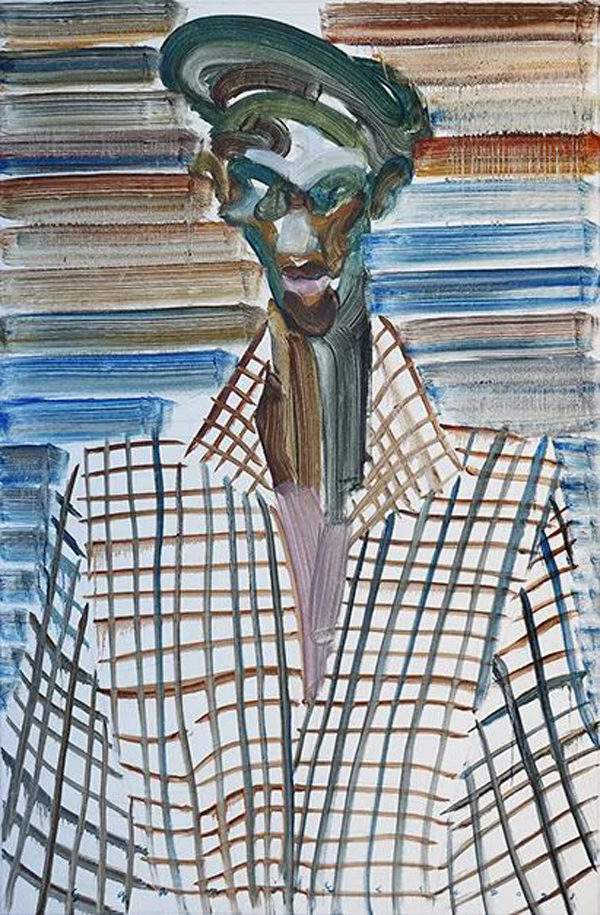
Rainbow display at JINGART. Courtesy of the artist
Hu Lingyuan: The “face” is a key symbol in your work, shifting between figurative and abstract expressions such as sharp outline and distorted features. What is the uniqueness of this expression? How do you strike a balance and grasp this expressional method?
Etsu Egami: When I was studying in China, the Japanese pronunciation of my name was “Egami Etsu,” which my northeast classmates mispronounced as “a cup of rice.” My classmates laughed, and I thought it was very funny at the time. A name can be translated into something completely different name through a different sound and pronunciation. This minor difference opened a world of possibilities for me. As a result, in my project “This Is Not A Mishearing Game” (2016), I began to involve people in a mishearing way to explore these topics, like what constitutes mishearing, what exactly is truth, and what exactly is human perception. The information conveys parallel lines, transmission, mutations, distortions, and rhythms are like a portrait without outline, intersecting with each other in an unstable and constantly changing approach.
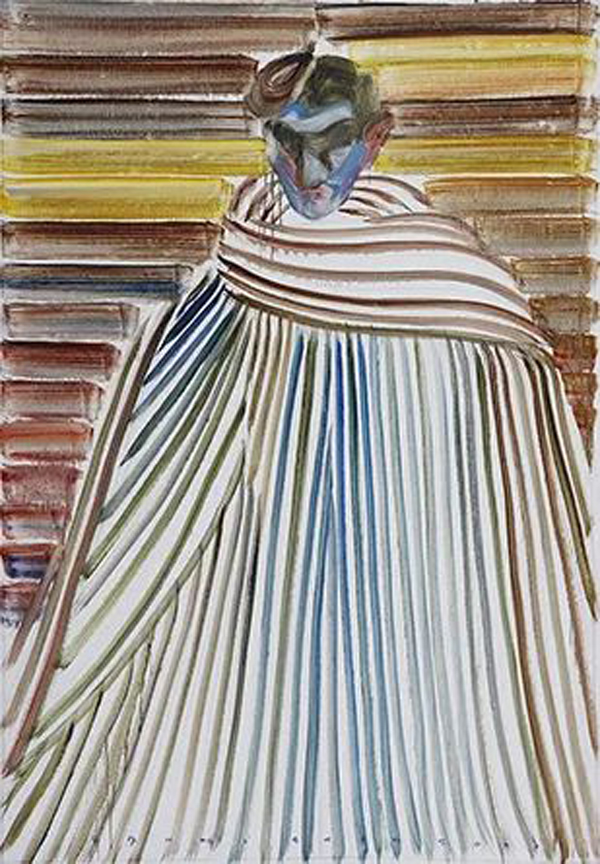
Rainbow. Collector: Yusaku Maezawa. Courtesy of the artist
Etsu Egami: “Face” is the window through which information is communicated, as well as the surface of inner expression. How do I visualize my perception of communication? Every muscle and every nerve in the face serves as the best vehicle. When my recognition resonates with the entity of the “face,” I can use my brush and colors at will. The “face” I paint is objective but also subjective, so I am not constrained by surface form or innate concepts, but rather spit it out.
Hu Lingyuan: In addition to easel painting, you also work with video and installation, such as “In to the Light…” This is a piece you created after studying art therapy of hospice care in a hospital in Karlsruhe City, Germany. I am also interested in art therapy. Can you share with me about it?
Etsu Egami: I can honestly say that my time in Germany was unforgotten. Many patients were no longer able to be treated with medicine, so how could they face “living” in the limited time they had left? I felt helpless at the time because art could not help them sustain life, which was also very depressing for me. We would, however, allow patients to draw. Once upon a time, a patient lacked the strengthen to paint, so she let me paint the scene she desired to see, and when I finished, she did not say nothing and burst into tears. This made me feel the fragility and resilience of life, as well as the significance of art.
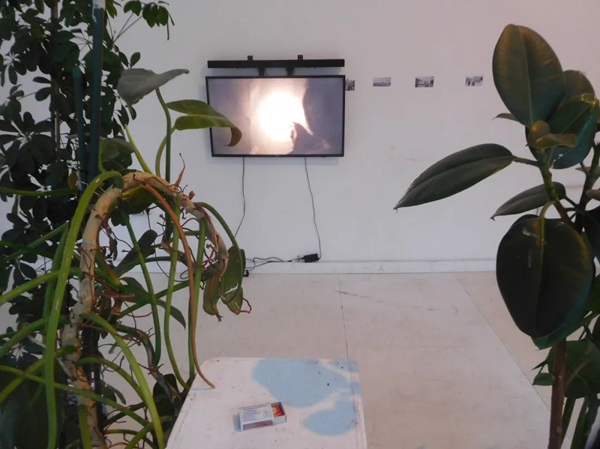
Into the light... Etsu Egami solo show (Germany), installation and video, 2017. Courtesy of the artist
Hu Lingyuan: You later had a solo exhibition in Germany related to this work; what did you wants to convey?
Etsu Egami: My solo show in Germany, “In to the Light…” was based on the works I created after I participated in hospice care in a hospital in Germany. Germany is a large insurance country, but what does insurance entail? It reminded me of the Japanese TV series “The Great White Tower” while I was in the hospital. The fragility and transience of life also reminded me of Hans Christian Anderson's fairy tale “The Little Match Girl,” in which the brief burning of the matches is a metaphor for people's wishes and various “insurances” before they die. So, my work is comprised of the faint light of the fire and the massive insurance institution, and I hope to make people feel life while also reflecting on society. My solo exhibition in Germany resulted from these real-life experiences and introspection.
Hu Lingyuan: Language creates barriers for you, but you constantly overcome them and even enjoy them (if I can understand it that way). What kind of interesting and artistic thinking do you think language condenses in your experience from Japan to Europe, America, and China?
Etsu Egami: Language is both a tool for communication and a barrier to communication. If we follow the Tower of Babel Bible story, we used to speak the same language and could communicate without barriers for a long time, but then we began to scatter due to the God of the Tower of Babel, and different languages gradually emerged. However why do we speak in different languages? I believe this is because cultures require diversity as well. And the world requires diversity in vitalism. Because of the COVID19, many scholars now argue that maintaining diversity is the only way to avoid extinction. It has been 4 billion years since the first life on Earth appeared, and 1.75 million species of life have evolved as a result of cell division and environmental mutation. Humans challenged the Tribe through the “Wall-facer” in the science fiction novel "The three body problem.” Language, communication, difference, and diversity are all themes that I explore in my art because I want to talk about human nature through the origins of language and then reflect on the society that language has created.
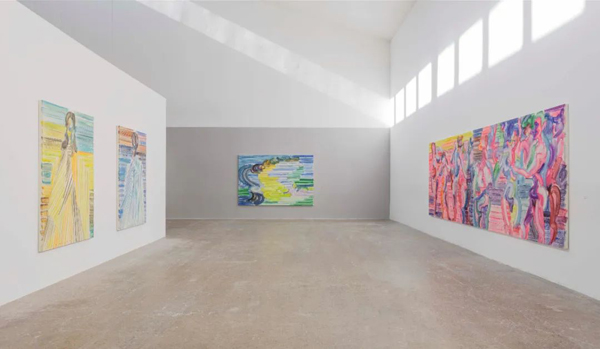
Etsu Egami solo show at Tang Contemporary Art, 2021. Courtesy of the artist
Hu Lingyuan: You have stated, “I cherish the faces of people passing by even though there are more misunderstandings and dislocations.” The work exhibited at Tang Contemporary Art Center (December 8, 2021) were all completed during the COVID19. Have you thought about misunderstandings in a new way in our social distance? Does this form another new expression for your creation?
Etsu Egami: This time, due to COVID19, Japan declared a state of emergency several time, and I was unable to go out. So, I stayed in my studio in Japan and finished this series. We have to keep distance in the real world, and our close communication is naturally hindered. We can only communicate through the internet, which is full of true and false and blurred outline lines. Under such conditions, even words and paintings cannot escape the mutated conditions that occur in the transmission of information. During pandemic, invisible boundaries between people, countries, and nations emerge and become visible.
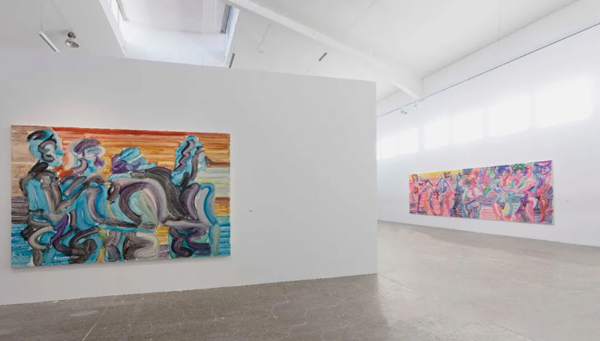
Etsu Egami solo show at Tang Contemporary Art, 2021. Courtesy of the artist
Etsu Egami: My investigation into communication is more about “misunderstanding.” What is people’s “perception”? In fact, these works are closely related to my first solo exhibition, “This Is Not A Mishearing Game”, which took place in Beijing. These “mishearing” may be caused by a small mistake, but they reflect your profession, your upbringing, your subconscious, and even your DNA…. So, “In a Moment of Misunderstanding, All the Masks Fall.”
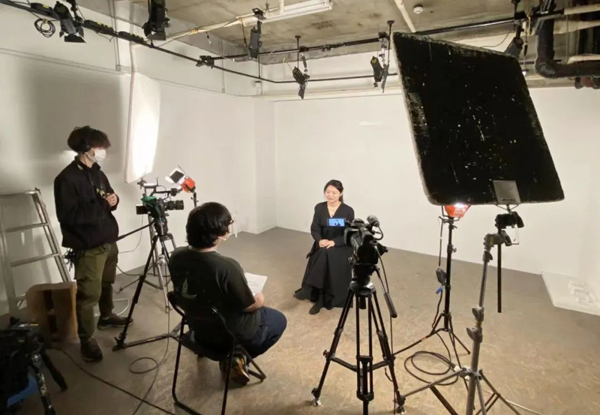
Life in Japan, Etsu Egami in a documentary filmed by BS Japan Fuji TV. Courtesy of the artist
Hu Lingyuan: The faces in your work reminded me of “Two Billion Light Years of Solitude” that you also mentioned. I happened to read it at the Queens Library before the pandemic, and there is a verse in this poem, “and sometimes wish for friends on Mars…But sometimes they like to have friends on Earth… Universal gravitation is the power of solitudes, pulling each other. Because the universe is distorted, we all seek for one another.” What kind of human condition do you think you draw in your paintings?
Etsu Egami: “Two Billion Light Years of Solitude” is a collection of poems that I first read in my elementary school language book. But I don’t know the reason why this poem always arises in my mind when creating. We cannot choose our birth, our country, or era. From the moment we are born, our country and era are predetermined by fate. Whether you’ll meet someone you like, whether you’ll have money, and whether you’ll have a family. But Humans world is full of vicissitudes; live in the world is all about loneliness. That is why we are all eager to communicate, and some scientists believe that the emergence of language is the origin of mankind. And humans as a group produced inventions because of their constant curiosity, resulting in iterative update that eventually drove the times. Newton, for instance, coined the term “gravity” to describe the natural phenomenon he discovered. Through painting, I hope to delve into the depths of human nature and visualize the essence of communication.
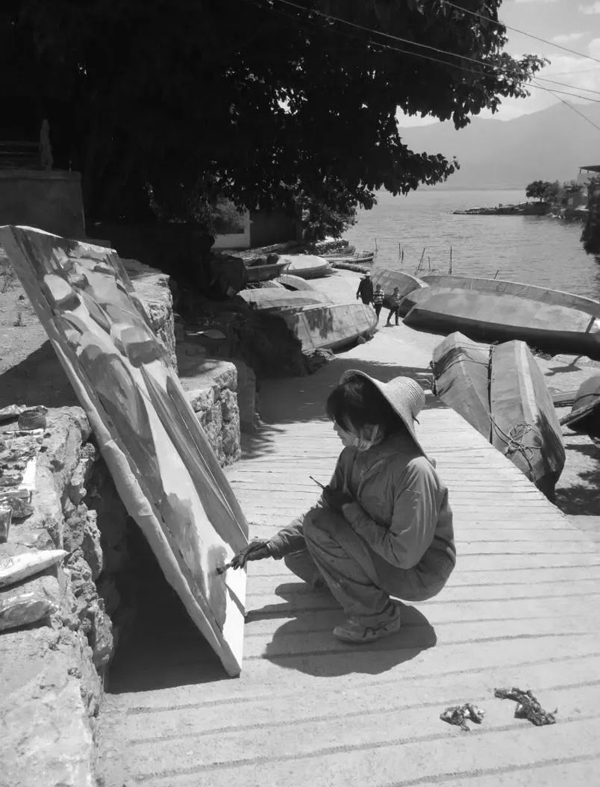
Sketching in the countryside in Yunnan during the Central Academy of Fine Arts. Courtesy of the artist
Hu Lingyuan: You completed your undergraduate and PhD in Beijing, China. What did you find in the soil of Chinese contemporary art that enables you to study here?
Etsu Egami: When I was an undergraduate at the Central Academy of Fine Arts, it could be said that Japan knew very little about contemporary art in China, and there was a sense of mystery. While learning there, I discovered that, despite their geographical proximity, the development of art in China and Japan is vastly different. The soil of Chinese contemporary art served as a catalyst for me, inspiring me not only to become interested in Chinese contemporary art, but also to reflect on my thoughts on Japanese contemporary art. I was researching the history of the Central Academy of Fine Arts at the time and found that many Japanese artists came to Beijing in the 1930s. I then began researching recent art exchanges between China and Japan, and in 2019, I noticed clues to recent exchanges between China and Japan and created my work “Bewilderment (2021).” This work was shown at “Where Are We?” held by CAFAM (Central Academy of Fine Arts Museum). From 1937 to 1939, Hattori Ryōei was the vice principal of the Beijing Fine Arts School (the forerunner of the Central Academy of Fine Arts). He also shown with some Chinese artists such as Qi Baishi and Wei Tianlin, and he has strong ties to China. However, this is not widely known in China and Japan. I was later able to locate his children and grandchildren through various ways. However, what I learned from his descendants was more about the family, and his artistic life seemed to have been lost in the passage of time and intergenerational transmission.
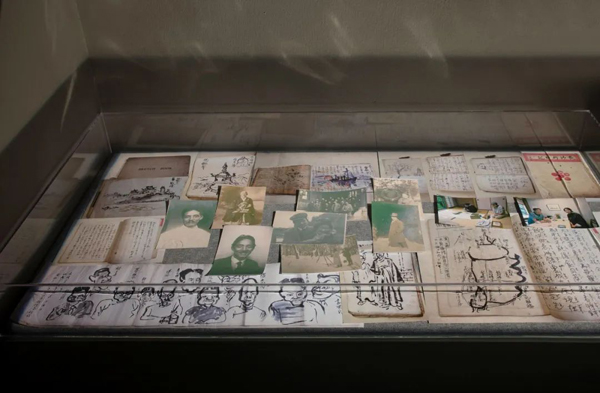
Bewilderment, 2021, installation, Central Academy of Fine Arts Museum (“Where are we?” Arts Exhibition of Young Artists’ Staying-in-Japan Arts Practice, CAFA). Courtesy of the artist
Etsu Egami: I can't help but think that the image reflected on the mirror surface is constantly being partially gutted in the spreading process, while being partially amplified in another reflection. This is the mutation and dislocation that occurs in information communication, and the misshapen reflection alludes to the recent complex relationship between China and Japan.
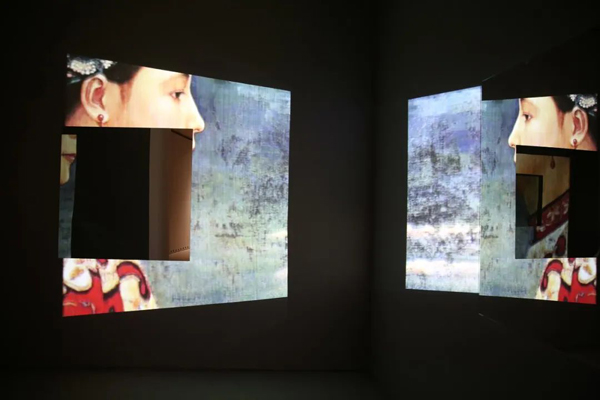
Bewilderment, 2021, installation, Central Academy of Fine Arts Museum (“Where are we?” Arts Exhibition of Young Artists’ Staying-in-Japan Arts Practice, CAFA). Courtesy of the artist
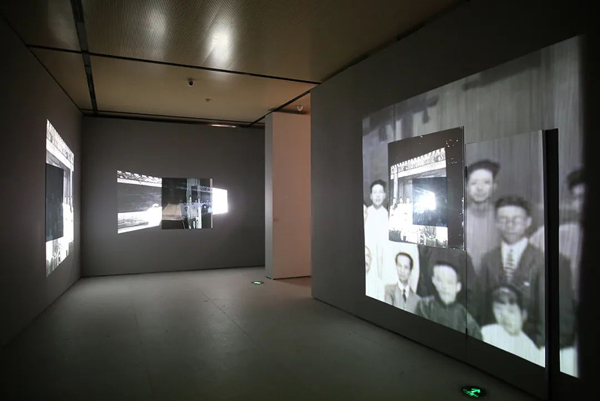
Bewilderment, 2021, installation, Central Academy of Fine Arts Museum (“Where are we?” Arts Exhibition of Young Artists’ Staying-in-Japan Arts Practice, CAFA). Courtesy of the artist
Hu Lingyuan: As the youngest person on the Forbes list and selected by the Agency for Cultural Affairs, Government of Japan as an outstanding artist to dispatch to New York, you are now a hot art star. What are your next artistic plans and arrangements?
Etsu Egami: Fobes was supposed to hold an international awards ceremony in the United States, but it was canceled because of COVID19. And I was chosen as a finalist of CAF which is Yusaku Maezawa founded. In the dispatch program of Agency for Cultural Affairs of Government of Japan, I had the opportunity to meet with Alexandra Munroe of the Guggenheim and Sarah Suzuki of the MoMA’s Associate Director and Samantha Friedman.
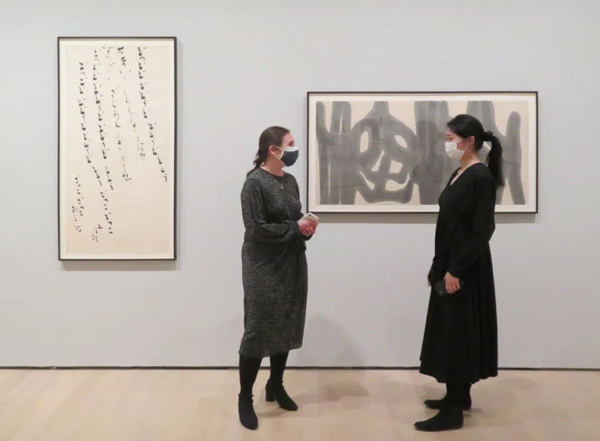
Etsu Egami with Samantha Friedman, associate curator of MoMA. Courtesy of the artist
Etsu Egami: I am currently pursuing a PhD, so I have recently been writing my doctoral dissertation while also working on some projects with Takeo Obayashi , the founder of OBAYASHI CORPORATION, Yoshihisa Kawamura, the president of Kawamura Memorial DIC Museum of Art, and Yoshiko Mori, the president of the board of directors of the Mori Art Museum in Japan; I will also have my first solo exhibition in Switzerland in April 2022, as well as a solo exhibition in Paris in June. I will have a solo exhibition at a major art museum in Japan in the second half of the year. I am honored to have this solo show alongside the works by Van Gogh, Renoir, and other art history masters. I am hoping to do my best to create more in-depth works and to keep exploring.
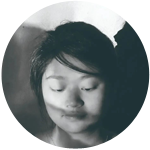
Etsu Egami, Artist from Japan, nominated as Forbes Asia 30 UNDER 30 in 2021 as the yougest artist. Graduated from Germany HFG Karlsruhe and CAFA Beijing, 2017 got the Chiba City New Artist Prize, Sovereign Art Foundation Asian Art Prize Finalist 2019,Japanese collectors Prize 2020, finalist of important exhibition of painting VOCA, CAF exhibition by Contemporary art foundation by Yusaku Maezawa. 2021 Etsu Egami was dispatched as talented artist program by Agency for Cultural Affairs Japan Government to New York to meet curator from MOMA, Dia Beacon and Guggenheim museum.
Selected solo exhibition including “Entrance gallery VOl.1 Etsu Egami” in Chiba City Museum of Art,at the exhibition hold a international talk with Julie Champion from Centre Pompidou, You Yang deputy director of UCCA, Chiba Shigeo, Etsu Egami. Another solo show including “In a Moment of Misunderstanding, All the masks fall”Tang Contemporary, “Social Distancing” A2ZPARIS, “Star time” GINZASIX, talk with Teiya Iwbuchi director of BT and Hiroki Yamamoto, Kawai Masatomo director of Chiba City Museum of Art, Chen KuangYi from Taiwan National Art University, Zhen Yan about the relationship between art and literature. At the solo show “Facebook” in Chambers Fine Art NY, during the exhibition Etsu Egami was invited by Museum of Fine Arts, Boston to have artist talk. ”Dialogue beyond 4000 years”London solo show,“This is not a Mis-hearing game”de Sarthe gallery, Beijing,”In to the light...” Germnay solo show. Selected group show including at “Grounding”UCCA,Beijing, VOCA2020, Ueno-Royal museum, Japan, Negotiating Space: I Never Thought You Were Like That – Third CAFAM Biennale, CAFA Art Museum, Beijing, China; Neither Here nor There, Yuan Dian Art Museum, Beijing, China .
Growing up in United States and Europe, and currently living and working in China, Etsu Egami experienced various communication barriers she encountered as a result. She felt that languages can “only be sensed, not explained”, thus becoming more interested in the discipline of language and communication. Etsu’s works comprise of various media forms, such as paintings voice, video and drawings, through which she strives to question human’s instincts and the authenticity of communication. Curator of Pompidou art center Julie said about her , “I saw all these specificities as a source, not only of misunderstanding, but also of creation and richness in people’s relationships. ”. Chinese curator Feng Bo Yi also said “Etsu’s creation is about the concept and the significance of ‘communication’. Through the paintings and videos which embodies these mishearing games, as well as the evolution of times, the clashes between civilizations, we acquire a discourse on the barriers in language communications, and subsequently even trigger a crisis.”


